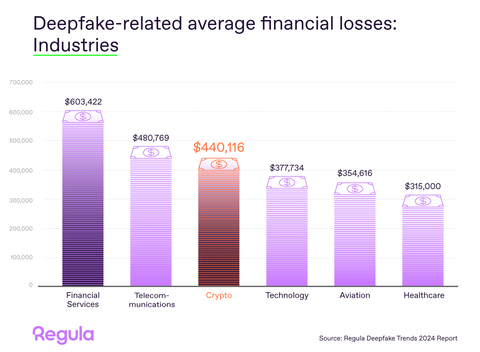
RESTON, Va.–(BUSINESS WIRE)–Regula, a global developer of forensic devices and identity verification solutions, reveals new survey findings, “The Deepfake Trends 2024.” The stats highlight the financial impact deepfake fraud has on businesses across industries and countries. While the average loss for most organizations reached $450,000, the Financial Services sector experienced a greater burden, exceeding $603,000.
Losses of up to $450,000 appeared to be a reality for 92% of surveyed businesses. Moreover, 10% of organizations reported losses exceeding $1 million, underscoring how severe the problem is.
What is more alarming, Regula’s earlier research from 2022 indicated that the average financial burden of identity fraud was around $230,000 — almost half the current figure. This sharp increase in just two years illustrates the rapid evolution of the threat landscape, and highlights the urgency for organizations to strengthen their defenses against deepfakes.
Breakdown by industry and geography
Among all the surveyed industries, Finance was found to be the most affected by video and audio deepfakes: 23% of surveyed organizations in this sector reported more than $1,000,000 in losses due to AI-generated fraud; meanwhile, the global average is half as much.
Notably, Fintech experiences more losses than Traditional Banking: the mean amount for these industries reached $637,000 and $570,000, respectively.
Financial losses also vary significantly not only by industry, but also by region. Mexico reported the highest average losses at $627,000, followed by Singapore with $577,000, and the USA at $438,000. Meanwhile, Germany and the UAE reported a slightly lower, but still significant, burden of $394,000 and $379,000, respectively.
False confidence?
The study also reveals a concerning gap between organizations’ confidence and competence. While 56% of businesses claim they are very confident in their ability to detect deepfakes, only 6% report having avoided financial losses from these attacks.
“The significant gap between confidence in detecting deepfakes and the reality of financial losses, particularly in Financial Services, shows that many organizations are underprepared for the sophistication of these attacks. As the threat evolves, it’s crucial for companies to switch to a liveness-centric approach, which we adhere to at Regula. This approach is focused on dealing with physical objects only — both faces and documents, as well as their dynamic parameters — in real time, which can significantly decrease the chances of falling victim to a deepfake attack. Additionally, it’s advisable to use multiple layers of identity verification and choose highly reliable technologies, like secure server-side reprocessing of all document and biometric checks,” says Ihar Kliashchou, Chief Technology Officer at Regula.





































